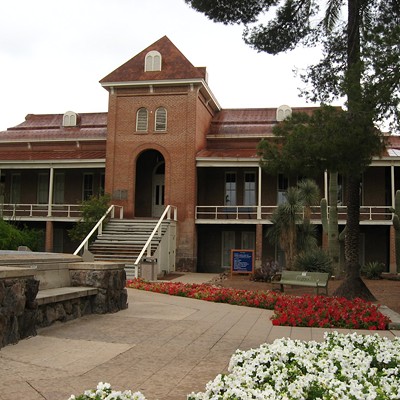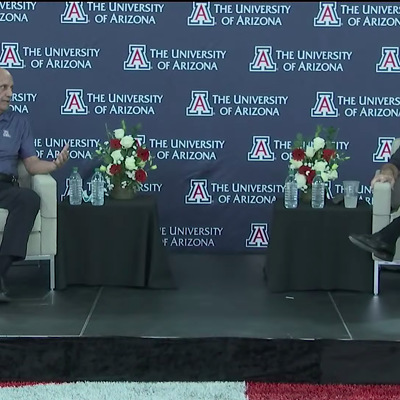But even as work continues on expanding the library, redoing the student union and enlarging McKale Center while it winds down on the underground Integrated Learning Center, the UA plans to proceed with even more construction projects. Attention now, however, will be paid to the west and south sides of campus.
Slated to be under construction by the end of the year is a 150-unit, 225-bedroom housing project along Euclid Avenue between Fourth and Fifth streets, a site now occupied by a parking lot. Negotiations are currently underway with a private developer who will finance and build the project. The university's role will be to lease the land, provide some management for the facility, and then assume ownership after 30 years.
The new project will be two to four stories high and have an architectural character in keeping with the adjacent West University Neighborhood historic district. University planners are adamant that the building not look like the one-year-old Soviet-style student apartment house on Stone Avenue and University Boulevard, which they politely label "inappropriate for the campus context."
This new housing is intended to serve mostly graduate students, but it may be used for undergraduates if the need arises. Only a few months ago it was scheduled to open in August of next year, but that has been pushed back to the summer of 2003.
Also very optimistically planned to be finished within two years is a two-story, 150-unit, 345-bedroom project for students with children. The tricky thing about this complex, though, is the university isn't supplying a site for it.
In a recently released request for proposals, the UA asked developers to submit ideas by November of where and what type of family student housing project they would pay to build. Options include either new construction or substantially modified existing residential units.
Unlike the other new housing effort, the family student project will only have a "referral agreement" tying it to the university. This means, according to the RFP, that campus officials will "direct, encourage, and assist appropriate University students, staff and faculty to the Proposer's housing facility for the purpose of leasing." In exchange, the university will review the plans for the project and require that a free rental unit, and a $25,000 salary, be set aside for a UA program coordinator.
Both of these projects are intended to replace the student housing the university sacrificed at Christopher City in the name of health concerns over mold. That complex, which is still awaiting demolition, provided hundreds of students and their families with low-cost housing in a friendly neighborhood setting.
The two new complexes are to supply units at rents that are at or below market rates. So an unfurnished, two-bedroom unit, which at Christopher City last year leased for $486 per month including utilities, can be expected to demand at least twice that amount in both new housing projects.
The university, however, may use some of the $8.9 million proceeds from the sale of the Christopher City property to reduce those rental rates. According to UA officials, $2-$3 million may be available for that purpose, but final figures have yet to be determined.
One developer who may be bidding on the family student housing project is Jerry DeGrazia, the man who bought the Christopher City property at Ft. Lowell Road and Columbus Boulevard a few months ago. He thinks neighbors of the former university complex may be pleased with the idea. But he added, "We're just at the start of a process for the property and are trying to evolve a plan for it."
According to David Duffy, head of the UA's department of Campus and Facilities Planning, these two new housing projects demonstrate the university's commitment to graduate-student and family housing. Former Christopher City resident and current University of Arizona student Jake Elkins disagrees.
Elkins says that college campuses around the country have great family housing units, but not Arizona. Instead, he says, the UA evicted people from Christopher City in order to make a fast buck rather than to protect their health. As for the amounts to be paid by future occupants of the new housing projects, Elkins believes the proposed rent structure "sends the message that graduate students shouldn't come here. The University of Arizona is very student unfriendly."
IN ADDITION TO THE housing project along Euclid, the west side of campus should also see some major street changes within a few years. As part of the new residential development, the builder will be required to turn Fifth Street into a pedestrian-oriented open space where most traffic is banned. This change from asphalt to vegetation, according to Duffy, will terminate an east-west landscape belt that runs through the campus.
At the same time, long-delayed plans for changing Tyndall Avenue into a similar pedestrian-friendly street between Sixth Street and University Boulevard are slowly moving along. Campus planners say this project is the "zipper" that will unite the west side of campus, and they hope the project can be completed by the summer of 2003.
Construction will also soon begin on several projects further east along Sixth Street. These include a new 1,700-space parking garage with an adjacent 16,700-square-foot office structure to be built starting this fall at Sixth Street and Santa Rita. Work is scheduled to begin next year on a 700-bed dormitory near Sixth Street and Highland. It will be constructed in two phases, and the first part of the project should be open by August of 2003. That is also the approximate date for completion of Highland Commons, a new health services building to be located near the new dorm.
Duffy thinks now may be the time for the community to start looking at redeveloping the remainder of Sixth Street near the campus, which was once a prospering locally-owned commercial strip. "The north side of the street," he says "will be transformed by these projects. The street itself will have more shade and become more pedestrian-friendly. Maybe it is time for the city and university to partner on a project to transform Sixth Street into Tucson's version of Mill Avenue in Tempe."
While preparations are being made for these new construction projects, the UA is also in the midst of updating its campus plan. Being prepared by the firm of Ayers/Saint/Gross, revisions are expected to be completed by the end of next year. One goal of the process is to increase density while preserving open space.
Even though the campus has added many new buildings over the past few years, its size has not changed substantially. Thus, vacant land within its boundaries is dwindling.
But at least one parcel will be available for a new use. The present site of the ill-fated Arizona International College at Speedway Boulevard and Cherry Avenue should be vacated by 2003, when the institution relocates to a Pima Community College campus on Tucson's northwest side. That move will supply a few acres on which even more campus buildings can someday rise.












